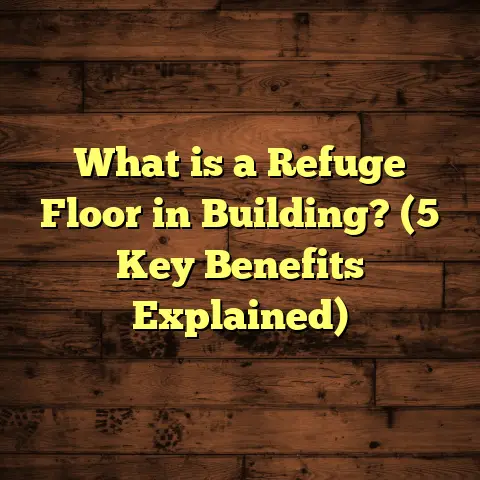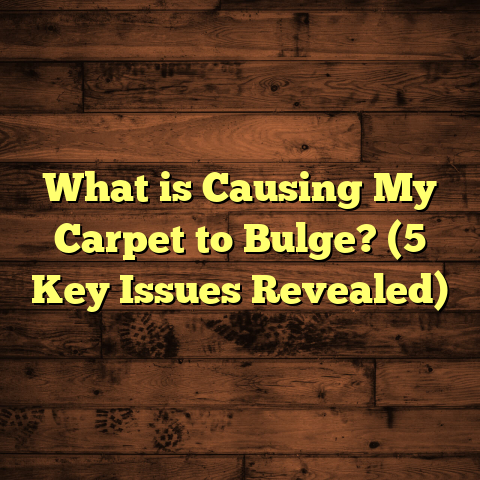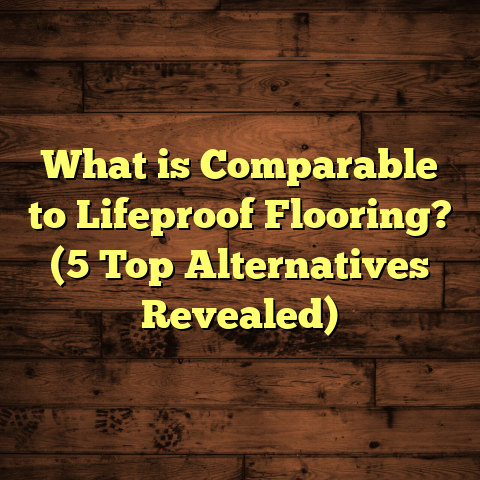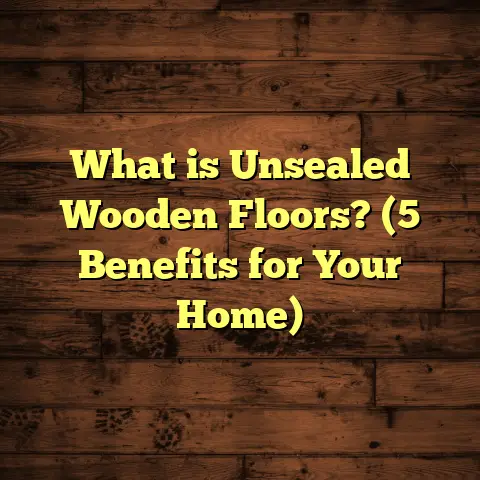What is Non-Toxic Flooring for the Home? (5 Benefits You Need)
Have you ever wondered what’s really beneath your feet in your home? Not just the wood or tile you see but the hidden chemicals and materials that could be affecting your family’s health every single day? I’ve spent years working in flooring installation and renovation, and one thing I’ve learned is that the flooring you choose isn’t just about looks or durability—it’s about safety and wellness too. That’s why I’ve become passionate about non-toxic flooring options.
I want to share everything I’ve learned about non-toxic flooring: what it means, why it matters, how it compares to other options, and the benefits that have made me a strong advocate for it. Along the way, I’ll share personal stories from jobs I’ve done, insights from research, and some practical tips for anyone thinking about making the switch.
What Is Non-Toxic Flooring?
Let’s start with the basics. What is non-toxic flooring? It’s a type of flooring made without harmful chemicals, synthetic additives, or materials that release pollutants into your home’s air. These floors avoid volatile organic compounds (VOCs), formaldehyde, phthalates, heavy metals, and other substances that can degrade indoor air quality.
You might be used to hearing about “green” or “eco-friendly” floors, but non-toxic flooring specifically focuses on health impacts rather than just environmental ones. Of course, many non-toxic floors are also eco-friendly, but the core idea is creating a safe living space—especially important if you have kids, pets, or anyone with allergies or asthma.
Why Does Flooring Matter for Indoor Air Quality?
You may not realize it, but flooring can be one of the biggest contributors to indoor air pollution. Many conventional floors—especially vinyl and laminate—are made with plastics and adhesives that off-gas VOCs over time. These chemicals don’t just disappear; they linger in the air you breathe every day. Studies by the Environmental Protection Agency (EPA) show indoor air can be 2 to 5 times more polluted than outdoor air, with VOCs from flooring and furnishings as major culprits.
When I first discovered this, it blew my mind. We protect our homes from dust and dirt but often ignore what’s poisoning the air inside. Non-toxic flooring cuts those emissions right at the source.
Materials That Qualify as Non-Toxic Flooring
Here are some of the common materials I’ve worked with or researched that fit into this category:
Natural Hardwood
Real hardwood is naturally non-toxic if finished with water-based or natural oils instead of chemical sealants. Some finishes contain formaldehyde or solvents, so always check labels or ask your contractor. Over the years, I’ve preferred using tung oil or beeswax finishes for clients who want a safe finish that still lasts.
Bamboo
Bamboo is a fast-growing grass harvested sustainably in many cases. When untreated or finished with non-toxic coatings, it’s an excellent non-toxic option. I used bamboo in a beach house once where salt air ruined other floors quickly; bamboo held up well and was safe for the family’s allergies.
Cork
Cork comes from the bark of cork oak trees without needing to cut down the tree. It has natural antimicrobial properties and absorbs sound well. In a meditation studio I worked on, cork created a calm environment free of chemical odors.
Linoleum
Made from linseed oil, wood flour, tree resins, and natural pigments, linoleum is biodegradable and safe when sealed properly. It’s different than vinyl, which is plastic-based and often toxic. I installed linoleum in a daycare center because it was durable and safe for crawling toddlers.
Wool Carpets
Natural wool carpets without synthetic treatments are soft and breathable. They resist dust mites naturally if untreated with chemicals. One client with severe asthma was relieved when we replaced their old synthetic carpet with untreated wool.
How Non-Toxic Flooring Compares to Conventional Options
To help you get a feel for where non-toxic flooring stands compared to standard flooring materials, here’s a breakdown based on my experience:
| Flooring Type | Toxicity Risk | Durability | Maintenance | Cost | Comfort |
|---|---|---|---|---|---|
| Vinyl | High (PVC & plasticizers) | Moderate | Easy (waterproof) | Low | Low (hard) |
| Laminate | Moderate (glues & resins) | Moderate | Easy | Low-Medium | Low |
| Engineered Hardwood | Variable (depends on finish) | Good | Moderate | Medium-High | High |
| Natural Hardwood | Low (with proper finish) | High | Moderate (refinishing) | Medium-High | High |
| Bamboo | Low | High | Moderate | Medium | High |
| Cork | Low | Moderate | Requires gentle cleaning | Medium | Very High |
| Linoleum | Low | Moderate-High | Moderate (sealing needed) | Medium | Moderate |
| Wool Carpet | Low | Moderate | Requires vacuuming | Medium-High | Very High |
I’ve installed both vinyl and laminate floors early in my career because they’re budget-friendly and quick to lay down. But after dealing with clients who reported headaches or allergic reactions, I started exploring alternatives.
One case sticks out: A family moved into a new house with expensive vinyl floors throughout. Within weeks, their child started coughing badly and developed skin rashes. After replacing the vinyl with cork flooring I installed using natural finishes, their symptoms improved drastically within a month.
My Story: Why I Started Advocating for Non-Toxic Flooring
When I began my career in flooring installation over 15 years ago, toxicity wasn’t something I thought much about. I focused on aesthetics and durability—what my clients asked for—and prices.
But after helping a client whose toddler had severe allergies and asthma, I realized something was wrong. The child’s condition worsened after installation of cheap laminate floors that emitted strong chemical smells. This pushed me to dig deeper into what was in those materials.
Since then, I’ve made it my mission to educate clients on healthy choices for their homes. I’ve tested finishes myself, researched material certifications like FloorScore and GreenGuard, and tracked health outcomes for families after installation.
This isn’t just about selling floors—it’s about creating safe spaces where people can thrive.
How I Use Data and Tools to Make Better Flooring Decisions
Estimating costs accurately while balancing health benefits can be tricky. That’s where tools like FloorTally come in handy for me.
FloorTally helps me quickly calculate total costs by incorporating local labor rates and material prices. It even includes waste factors so we don’t order too little or too much material. For clients concerned about budget but wanting non-toxic options, this tool helps me present realistic numbers upfront without surprises later.
For example, on a recent project installing cork in a 1,000 sq ft space, FloorTally showed me the cost difference between cork with low-VOC sealant vs. traditional vinyl—and allowed me to explain why spending more upfront could save money on health-related expenses later.
Deep Benefits of Non-Toxic Flooring
1. Cleaner Air Means Fewer Health Problems
We spend roughly 90% of our time indoors. Poor indoor air quality can cause headaches, fatigue, respiratory issues, allergies, and even contribute to chronic illnesses. VOCs from flooring are a major source.
The EPA estimates that VOC levels indoors can be 2-5 times higher than outside. Switching to non-toxic floors reduces these emissions tremendously.
One study showed that people in homes with low-VOC materials had 50% fewer respiratory symptoms over six months compared to those with conventional materials.
2. Safe Spaces for Kids and Pets
Kids crawl on floors all day; pets sniff and lie on them too. They’re especially vulnerable to chemical exposure through skin contact or breathing dust particles loaded with toxins.
After installing untreated wool carpets for one family whose child had eczema, the parents saw noticeable skin improvements within weeks.
Non-toxic floors reduce allergy flare-ups by cutting down irritants trapped in dust.
3. Sustainability That You Can See and Feel
Non-toxic flooring often aligns with sustainable harvesting methods. Cork trees aren’t cut down; bamboo grows back quickly; linoleum is biodegradable.
These materials reduce landfill waste and lower greenhouse gas emissions compared to petroleum-based vinyl or plastic laminates.
The U.S. Green Building Council reports cork flooring reduces landfill contributions by up to 90%.
4. Durable Floors That Age Gracefully
Many people assume natural materials are fragile—but with proper care, non-toxic floors can last decades.
For instance, hardwood floors finished with natural oils develop a beautiful patina over time and can be refinished multiple times without harsh sanding or chemical stripping.
I’ve seen bamboo floors hold up well even in high-traffic kitchens because they’re so dense. Cork requires more gentle use but still lasts years if protected from sharp objects.
5. Comfort and Aesthetics You’ll Love
Beyond health benefits, non-toxic floors often feel better underfoot. Cork absorbs sound and adds springiness. Wool carpets provide warmth and softness. Natural wood brings unique grain patterns no machine can replicate perfectly.
One client told me their natural hardwood floor “made their whole room feel cozy,” which is exactly what many of us want at home—a place that’s both beautiful and comfortable.
Challenges You Might Face With Non-Toxic Flooring
I want to be honest: non-toxic flooring isn’t perfect for every situation. Some challenges include:
- Higher upfront cost: Natural materials are often more expensive than vinyl or laminate. But this is balanced by long-term benefits.
- Maintenance: Cork needs regular sealing; wool carpets need gentle cleaning. But avoiding harsh chemicals in cleaners helps preserve floor health.
- Availability: Not all areas have easy access to certified non-toxic materials. Planning ahead helps overcome this hurdle.
- Installation expertise: Some materials require special knowledge to install correctly. Working with trained contractors makes all the difference.
How to Choose the Right Non-Toxic Floor for Your Home
If you’re thinking about switching to non-toxic flooring, here are some tips from what I’ve learned:
- Define Your Priorities: Is health your main concern? Or do you want a balance of durability and comfort? Knowing this helps narrow choices.
- Research Certifications: Look for products certified by FloorScore, GreenGuard Gold, or similar bodies that test for low emissions.
- Ask About Finishes: The finish matters as much as the material itself. Choose water-based or natural oil finishes.
- Consider Room Usage: High-moisture areas like bathrooms need water-resistant options like linoleum; living rooms may benefit from cork or hardwood.
- Get Samples: Always see and feel samples before buying—they can surprise you.
- Work With Professionals: A knowledgeable installer makes sure your floor is set up correctly to avoid problems later.
- Plan Your Budget: Use tools like FloorTally to estimate total costs including labor and waste so you don’t get sticker shock.
Personal Stories: What My Clients Have Told Me
I’ve helped many homeowners make informed choices about non-toxic flooring. Here are some quotes that stuck with me:
- “We didn’t realize how much our old floors were affecting our son’s asthma until we replaced them.” — Sarah M.
- “The cork floor feels amazing after yoga sessions—no chemical smell at all.” — Raj P.
- “I love how my bamboo floor looks natural but cleans easily without harsh products.” — Lisa K.
- “Switching to linoleum was the best decision for our daycare; kids are safer crawling around on it.” — Michelle T.
- “Using natural finishes gave my hardwood floor life without any headaches or allergic reactions.” — David R.
The Science Behind Non-Toxic Flooring
I wanted to understand the science behind these benefits deeply, so I reviewed several studies:
- VOCs and Health: VOCs like formaldehyde irritate eyes, nose, throat and worsen asthma symptoms according to research from Johns Hopkins University.
- Dust Mite Resistance: Cork naturally resists dust mites due to its antimicrobial tannins (University of Wisconsin study).
- Material Emissions: Tests by UL Environment found linoleum emits near-zero VOCs compared to vinyl which releases high levels over months.
- Sustainability Metrics: Bamboo’s rapid regrowth reduces carbon footprint drastically compared to hardwood forests (International Journal of Life Cycle Assessment).
These studies back up what my clients experience firsthand every day—better health from better floors.
Maintaining Your Non-Toxic Floors for Longevity
Non-toxic doesn’t mean no maintenance—it means careful maintenance:
- For hardwood finished with oils: Clean using mild soap and water; avoid harsh detergents. Re-oil annually to protect wood.
- Cork: Re-seal every few years; wipe spills immediately. Avoid dragging furniture without pads.
- Linoleum: Sweep regularly; use neutral pH cleaners; reseal as needed.
- Wool carpets: Vacuum gently; steam clean with natural products only; avoid synthetic stain removers.
From what I’ve seen personally: treating your floors well extends life significantly, saving money and reducing waste long-term.
Final Thoughts on Choosing Non-Toxic Flooring
Choosing non-toxic flooring isn’t just about avoiding chemicals; it’s about creating a home environment that supports well-being, comfort, sustainability, and beauty all at once.
When clients come back months or years later telling me their allergies cleared up, or their kids play comfortably on their new floors without irritation, that’s when I know this work matters most.
If you’re ready to explore your options, start by asking questions about what goes into your floors and consider how much healthier your home could be with nontoxic choices.
And remember tools like FloorTally can help make cost estimating simple, letting you compare scenarios quickly so you can make decisions confidently without surprises down the line.
If you want me to break down specific materials further, share installation tips, or even walk through budgeting step-by-step, just ask—I’m happy to share more insights from my experience working with homes just like yours.
What kind of floor do you think suits your lifestyle best? Have you noticed any health effects related to your current floors? Let’s chat!





